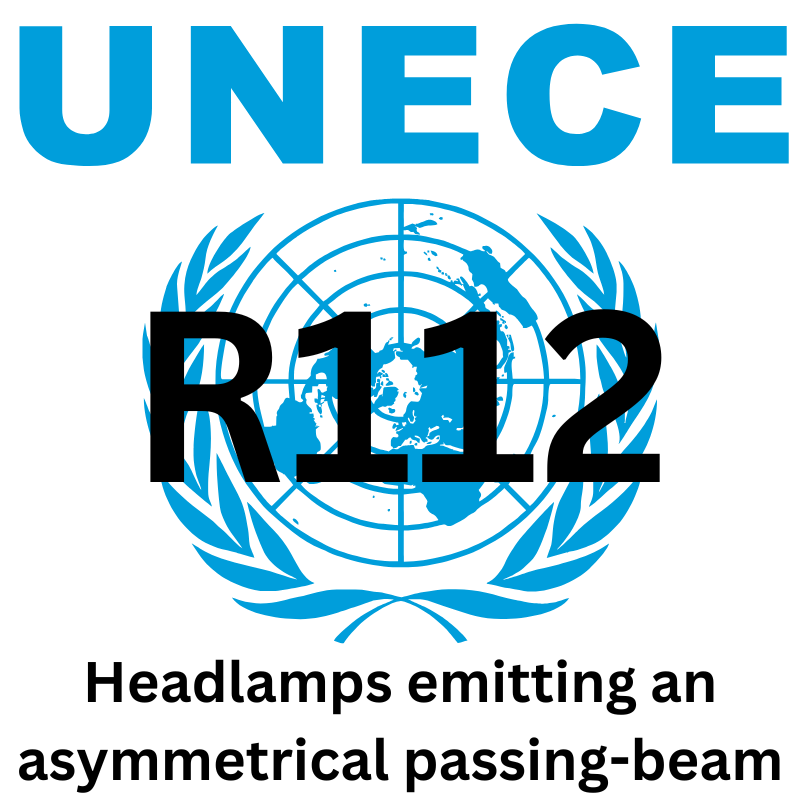Guide To: UNECE R112 - Headlamps emitting an asymmetrical passing-beam
23 October 2024

Guide To: UNECE R112 - Headlamps emitting an asymmetrical passing-beam
UN ECE Regulation No. 112 sets out uniform provisions concerning the approval of motor vehicle headlamps emitting an asymmetrical passing-beam, a driving-beam, or both, and which are equipped with filament light sources and/or LED modules. These headlamps play a critical role in ensuring proper illumination for vehicle drivers, enhancing visibility while maintaining safety for other road users. The regulation defines stringent requirements for design, performance, and safety to ensure headlamps function efficiently under all driving conditions.
Scope of the Regulation
UN ECE Regulation No. 112 applies to:
- Motor vehicle headlamps for categories L, M, N, and T vehicles, which include motorcycles, passenger cars, goods vehicles, and tractors.
- Headlamps equipped with filament light sources as per UN Regulation No. 37 and/or LED modules designed to emit either asymmetrical passing-beam or driving-beam.
Key Features of UN ECE Regulation No. 112
Design and Construction:
- The regulation requires that headlamps be designed to provide adequate illumination without dazzling oncoming traffic. This includes specifications for the optical system, beam patterns, and photometric characteristics to ensure safety and reliability.
- Filament light sources and LED modules used in headlamps must comply with their respective UN regulations (e.g., UN Regulation No. 37 for filament lamps and provisions in Annex 10 of this regulation for LED modules).
Markings and Approval:
- Headlamps must bear clear and indelible markings, including the manufacturer's trade name or mark and the approval marks, to confirm compliance with the regulation. For example, headlamps designed for right-hand traffic must be marked accordingly.
- Approval is granted after headlamps undergo extensive testing for photometric performance, stability, durability, and material quality, including additional tests for UV protection in plastic lenses.
Photometric and Performance Requirements:
- The regulation details rigorous photometric standards for both the passing-beam and the driving-beam, ensuring they provide sufficient illumination across different conditions. It includes provisions for preventing glare by ensuring proper "cut-off" lines for asymmetrical beams and defines testing points for measuring light intensity.
- Plastic lenses used in headlamps must undergo additional UV resistance tests to ensure they maintain clarity and photometric stability under prolonged exposure to light.
Passing and Driving Beams:
- Headlamps designed to provide both passing and driving beams must meet specific photometric standards. The passing-
beam (or low beam) is particularly tested to prevent glare while illuminating the road ahead effectively, while the driving-beam (or high beam) is tested for long-distance visibility.
LED Modules:
- Headlamps incorporating LED modules must comply with Annex 10 of the regulation. The LED modules used for the principal passing-beam must produce a minimum of 1,000 lumens, ensuring adequate light output. Specific requirements for the electronic light source control gear associated with LED modules are also outlined.
As part of the UNECE’s ongoing efforts to consolidate vehicle lighting regulations, UN ECE Regulation No. 112 has been incorporated into UN ECE Regulation No. 149, which governs road illumination devices. Regulation No. 149 unifies the standards for various types of headlamps, adaptive lighting systems, and other road illumination devices, simplifying the regulatory framework for manufacturers.
The consolidation of UN ECE R112 into R149 brings together provisions for filament light source headlamps and LED-equipped headlamps with other advanced lighting technologies, facilitating compliance with a single comprehensive standard. This streamlining process makes it easier for manufacturers to meet international requirements while embracing new lighting technologies such as adaptive front-lighting systems (AFS).
Conclusion
UN ECE Regulation No. 112 plays a crucial role in defining the safety and performance standards for headlamps equipped with filament light sources or LED modules. With its consolidation into UN ECE Regulation No. 149, the regulation now forms part of a broader framework governing vehicle lighting systems, supporting the global standardization of headlamp technologies. This ensures that headlamps provide optimal illumination while minimizing glare and enhancing road safety for all road users.